When it comes to Husky air compressor, you’re getting a workhorse without the luxury price tag. These machines have built a solid reputation by delivering reliable performance that won’t drain your wallet.
Think of an air compressor like a machine that captures air and squeezes it into a tank – kind of like filling up a balloon, but much more powerful. You can use this stored-up air to power tools, fill up tires, or run equipment in your workshop.
What makes Husky different from other brands? Three main things:
- They’re affordable – you get good quality without emptying your wallet
- They’re reliable – they keep working when you need them
- They’re versatile – whether you need to fill a bike tire or run power tools, there’s a Husky model that can handle it
Whether you’re a DIY enthusiast working in your garage or a professional needing dependable equipment, there’s likely a Husky air compressor that fits your needs.
Types of Husky Air Compressors
Let’s break down the three main types of Husky air compressors you’ll find. Each one is built for different needs, kind of like how you wouldn’t use a sports car to move furniture.
Portable Models
These are the lightweights of the bunch. Think of them as the grab-and-go options. Husky portable air compressors usually:
- Weigh between 20-30 pounds
- Have smaller tanks (2-8 gallons)
- Run on standard household power (120V)
- Perfect for tire inflation, nail guns, and small paint jobs
- Usually come with wheels or handles for easy movement
Silent Models
Nobody likes a noisy workshop. Husky’s quiet air compressors are built to keep the peace:
- Run at about 60-70 decibels (that’s quieter than normal conversation)
- Great for indoor workshops or garages
- Usually come in 20-30 gallon sizes
- Perfect for indoor construction, woodworking, or anywhere noise is a concern
Heavy-Duty Models
These are the big boys – the Husky pro air compressors that mean business:
- Large tanks (60-80 gallons)
- Usually stationary vertical tanks
- Often feature two-stage compression for more power
- Ideal for auto shops, manufacturing, or serious DIY workshops
- Can run multiple air tools at once
All these compressors work by using a pump to pressurize air into the tank. The pump is really the heart of the system – it’s what takes regular air and compresses it into the high-pressure air you need for your tools.
Portable Husky Air Compressors: Most Popular Models
Let’s break down the most practical portable Husky compressors, focusing on what makes each one special and what it’s best at.
Best for: Emergency tire inflation and small inflatables
Husky 12 Volt Inflator
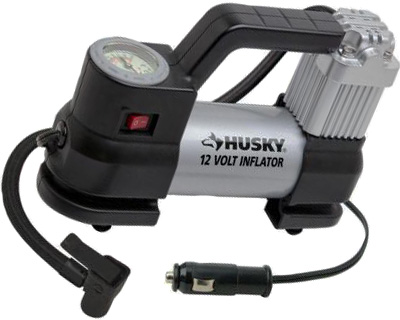
★★★★★ 9.5
Pros
- Ultra-portable (fits in your glove box)
- No need for a power outlet
- Digital pressure gauge for accurate filling
- Built-in LED light for nighttime use
Cons
- Limited to tire inflation and small tasks
- Can run hot with extended use
- Not suitable for air tools
This compact powerhouse comes with a 12-foot power cord that plugs into your car’s cigarette lighter or 12V outlet. It features a bright digital display showing real-time PSI readings and includes three nozzle adapters for different inflation needs. The unit automatically shuts off when it reaches your preset pressure, preventing over-inflation. At just 2.5 pounds, it’s light enough to store anywhere.
Perfect for: Keeping in your car for emergencies or road trips.
Best for: Home garage and recreational inflation tasks
Husky 120 Volt Inflator
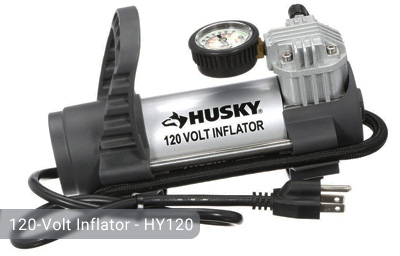
★★★★★ 9.6
Pros
- More powerful than the 12V version
- Can handle larger inflatables
- Multiple nozzle attachments included
- More stable operation
Cons
- Requires an electrical outlet
- Still not suitable for air tools
- Slightly bulkier than 12V model
This model packs a stronger motor than its 12V cousin, pushing out air at higher volumes. It comes with a 6-foot power cord, multiple quick-connect nozzles, and a more robust construction. The digital gauge reads in PSI, BAR, and KPA for versatility. At 3.5 pounds, it’s still very portable but delivers more consistent power than the 12V version.
Perfect for: Home garage, sports equipment, pool toys
Best for: Light DIY projects and finishing work
Husky 2 Gallon Portable Air Compressor (SAC22HPD)
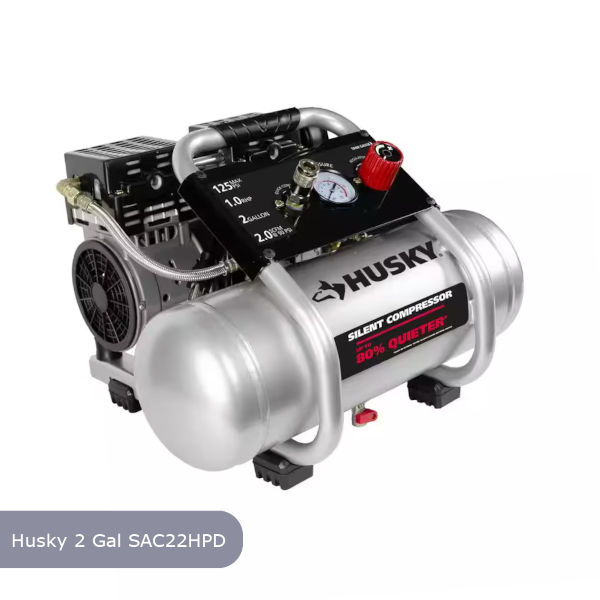
★★★★★ 9.4
Pros
- Oil-free pump (no maintenance)
- Very lightweight (under 20 lbs)
- Quick recovery time
- 150 PSI max pressure
Cons
- Small tank limits run time
- Can’t handle larger air tools
- Louder than inflator models
This 2-gallon powerhouse delivers 150 max PSI with an oil-free pump system. It features a roll-cage design for protection, rubber feet for stability, and a quick-connect coupler. The unit weighs just 19 pounds and includes a comfortable grip handle. With a 1.0 SCFM at 90 PSI, it recovers quickly between uses and includes both a regulator and pressure gauges for precise control.
Perfect for: Trim work, finish nailers, and light-duty tasks
Best for: Serious DIY and light professional use
Husky 8 Gallon Portable Air Compressor
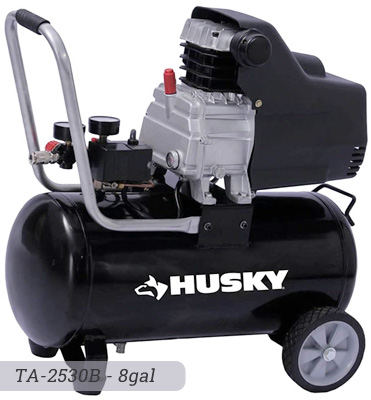
★★★★★ 9.6
Pros
- Wheels for easy movement
- Can run most air tools
- Oil-free design
- Good air delivery rate
Cons
- Heavier (around 60 lbs)
- Takes up more storage space
- Louder operation
This 8-gallon unit combines power with mobility, featuring pneumatic wheels and a sturdy handle for easy transport. It delivers 175 max PSI and 4.0 SCFM at 90 PSI, enough for most air tools. The oil-free, dual-piston pump system is designed for long life with minimal maintenance. It includes dual quick connects, allowing two tools to run simultaneously, and comes with a regulated pressure gauge system for precise control.
Perfect for: Home workshops, construction sites, and mobile work
General Buying Tips for Portable Husky Compressors:
- Consider your power source – 12V models are great for mobility, but 120V units offer more power
- Think about weight – If you’ll move it often, stay under 30 lbs
- Match the tank size to your needs – Bigger isn’t always better if portability is key
- Look for oil-free models if you want less maintenance
Best Silent and Low-Noise Husky Air Compressors
Nobody likes a noisy workshop. Let’s break down Husky’s quiet models – the ones that won’t make your ears ring or drive your neighbors crazy.
Best for: Small workshops and garages
Husky 20 Gallon Air Compressor (C202H)
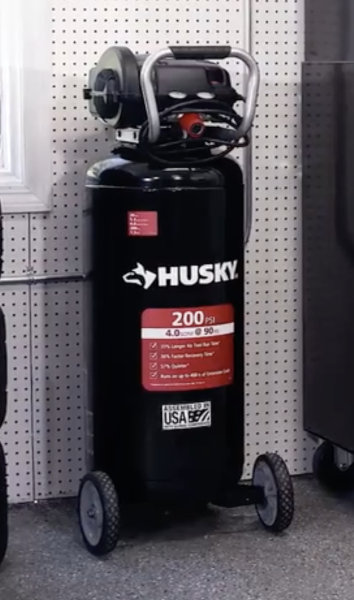
★★★★★ 9.7
Pros
- Relatively quiet operation
- No oil changes needed
- Good size for most home shops
- Can handle impact wrenches and other air tools
Cons
- Still makes some noise (not whisper-quiet)
- Takes up floor space
- Heavier than portable models
Running at 78 decibels (about as loud as a dishwasher), this 20-gallon unit delivers 175 max PSI and 4.0 SCFM at 90 PSI. It features rubber-grip wheels for mobility and oil-free operation. The unit uses sound-dampening technology and a low-RPM motor to keep noise down.
Perfect for: Home mechanics, woodworkers who need a quieter shop
Best for: Professional workshops needing more air capacity
Husky 27 Gallon Vertical Electric Quiet Air Compressor
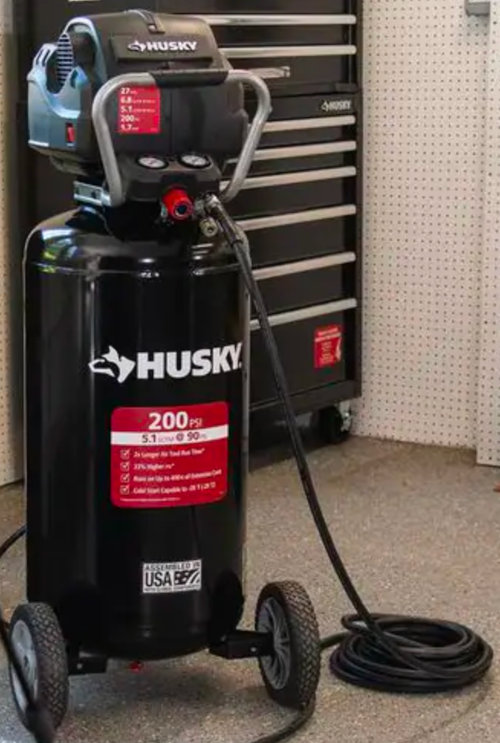
★★★★★ 9.8
Pros
- Very quiet for its size
- Space-saving vertical design
- High air flow rate
- Built-in wheels for mobility
Cons
- Higher price point
- Heavier unit (needs solid floor)
- Takes longer to fill initially
At 165 max PSI and running at 72 decibels (like a quiet conversation), this vertical tank saves floor space while delivering serious power. It puts out 5.1 SCFM at 90 PSI, enough for most air-hungry tools. Features dual quick connects and a heavy-duty roll cage.
Perfect for: Professional shops, serious DIYers needing quiet operation
Best for: Commercial use where noise is a concern
Husky 30 Gallon Ultra-Quiet Air Compressor (C304H)

★★★★★ 9.8
Pros
- Ultra-quiet operation
- High air output
- Works on home or shop power
- Superior build quality
Cons
- Premium price
- Large footprint
- Heavy unit (needs reinforced floor)
The quietest of the bunch at 67 decibels (quieter than normal conversation). Delivers 175 max PSI and 6.2 SCFM at 90 PSI. Features a dual-voltage motor that works on both home and shop power. Includes advanced vibration isolation and sound dampening.
Perfect for: Indoor construction, professional workshops near offices
Quick Comparison for Air Tools:
If you’re planning to use air impact wrenches, here’s what each model can handle:
- 20 Gal: Good for occasional impact wrench use – handles up to 3/8″ impact wrenches
- 27 Gal: Better for regular use – can power most 1/2″ impact wrenches
- 30 Gal: Best for constant use – capable of running 1/2″ or 3/4″ impact wrenches continuously
Speaking of impact wrenches, they’re one of the most common tools paired with these compressors. Check out our complete guide to the best air impact wrenches to find the perfect match for your compressor.
Heavy-Duty Husky Pro Air Compressors
When you need serious power, these are Husky’s biggest and baddest machines. These aren’t your everyday garage compressors – they’re built for serious work.
Best for: Small to medium shops
Husky 60 Gallon Air Compressor
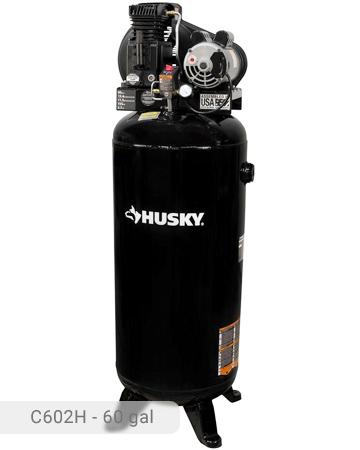
★★★★★ 9.7
Pros
- High air output for multiple tools
- Cast iron construction
- Long-lasting oil pump
- Built-in safety features
Cons
- Needs 230V power (special wiring)
- Heavy (over 300 lbs)
- Requires regular oil changes
This vertical tank beast runs on 230V power, pumping out 175 max PSI with 13.4 SCFM at 90 PSI. It uses a two-stage pump system with cast iron construction. The unit includes a low-oil shutdown feature and wire-form belt guard for safety.
Perfect for: Auto repair shops, small manufacturing facilities
Best for: Production environments
Husky 80 Gallon Air Compressor (C803H)
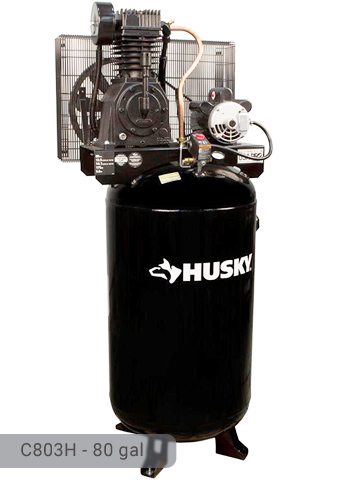
★★★★★ 9.7
Pros
- Massive air storage
- Industrial-grade pump
- Can run multiple big tools
- Better cooling system
Cons
- Very heavy (400+ lbs)
- Permanent installation needed
- Higher maintenance needs
Running on 230V, this 80-gallon monster delivers 175 max PSI and 15.5 SCFM at 90 PSI. Features a cast iron, two-stage pump and heavy-duty motor. Includes thermal overload protection and automatic start/stop control.
Perfect for: Production lines, large auto shops
Best for: Heavy industrial use
Husky 80 Gallon Air Compressor (TF2912)
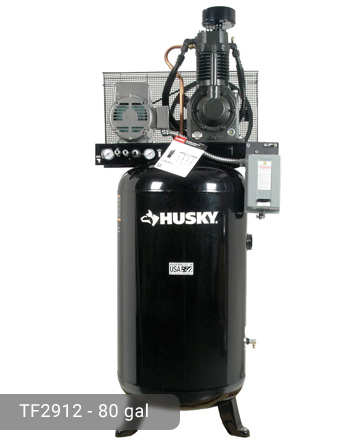
★★★★★ 9.8
Pros
- Highest air output
- Most durable build
- Best cooling system
- Lower vibration
Cons
- Most expensive
- Heaviest (450+ lbs)
- Needs professional installation
The biggest of the bunch, also running on 230V. Pushes 175 max PSI with 16.8 SCFM at 90 PSI. Features a commercial-grade cast iron pump and precision-balanced components for less vibration.
Perfect for: Machine shops, industrial facilities
Need even more capacity? Discover the best 80-gallon air compressors and find the perfect fit for your needs.
Quick Power Guide:
Think of SCFM (Standard Cubic Feet per Minute) like water flow:
- 60 Gal: 13.4 SCFM = Can run 2-3 big tools
- 80 Gal (C803H): 15.5 SCFM = Can run 3-4 big tools
- 80 Gal (TF2912): 16.8 SCFM = Can run 4+ big tools
Who Makes Husky Air Compressors?
Husky air compressors are manufactured for Home Depot’s private label brand. While Home Depot owns the Husky brand name, they don’t actually build the compressors themselves. Instead, different manufacturers produce these machines under the Husky name, with Campbell Hausfeld being one of the main manufacturers.
Think of it like this: Home Depot is the restaurant owner (they own the Husky brand), but they hire skilled chefs (the manufacturers) to make the food (build the compressors). This setup is pretty common in the tool world – it’s how many store brands work.
Here’s what this means for you:
- You can only buy new Husky air compressors at Home Depot
- The warranty and customer service come through Home Depot
- You get the backing of a major retailer while paying less than premium brand prices
Note: While Campbell Hausfeld is known to manufacture some Husky compressors, the specific manufacturer can vary by model and may change over time. If you need exact manufacturer information for a specific model, you’ll want to check the current product documentation.
Key Features and Benefits of Husky Air Compressors
Let’s talk about what’s under the hood of Husky air compressors. The motor is like the heart of your compressor – it needs to be strong and reliable.
Types of Husky Motors
Most Husky compressors use electric motors, and they come in two flavors:
| 120V Motors (Regular house power) | 230V Motors (Special power) |
|---|---|
|
|
Need help keeping your motor running right? Check out our Husky Air Compressor Motor guide to find the right motor for your compressor, plus maintenance tips and troubleshooting advice.
Motor Size Guide
- Small jobs (tire filling, nailing): 0.5-2 HP motors
- Medium jobs (painting, small air tools): 2-3 HP motors
- Big jobs (auto work, multiple tools): 3-5 HP motors
Essential Components
Let’s break down the key parts that make your Husky air compressor work. Think of these like the organs in a body – each one has an important job.
The Pump: Your Compressor’s Heart
Two main types you’ll find:
Direct-Drive Pumps
- Found in smaller units
- Motor connects straight to pump
- Less maintenance, fewer parts
- Usually oil-free
Belt-Drive Pumps
- Found in bigger units
- Uses a belt to connect motor to pump
- More efficient cooling
- Usually needs oil
Need help with your belt system? Check out our Air Compressor Belt and Pump guides to find the right belt or pump for your compressor and get maintenance tips.
Air Filters: Your Compressor’s Lungs
These keep dirt and debris out of your system:
- Located at the intake
- Needs regular cleaning
- Replaceable cartridge design
- Critical for pump life
Learn more about keeping your air clean in our Husky Compressor Filter guide.
Applications & Versatility
Let’s look at what you can actually do with your Husky air compressor. It’s not just about having air power – it’s about what you can accomplish with it.
Common Applications by Size
| Small Compressors (2-8 Gallons) |
|
| Medium Compressors (20-30 Gallons) |
|
| Large Compressors (60-80 Gallons) |
|
Matching Tools to Your Compressor
The key is matching your air tools to your compressor’s SCFM (air flow). Here’s what different tools need:
- Brad nailer: 0.5-1.0 SCFM
- Paint sprayer: 3.0-7.0 SCFM
- Impact wrench: 4.0-8.0 SCFM
- Sandblaster: 10.0-15.0 SCFM
Check out our complete Husky Air Compressor Tools guide to find the right tools for your compressor.
Quick PSI Guide
Most air tools need between 90-120 PSI to work right. All Husky compressors can handle this, but bigger tanks mean less stopping to let the compressor refill.
Maintenance and Troubleshooting
Let’s keep your Husky air compressor running like new. Regular maintenance isn’t complicated – think of it like changing the oil in your car.
| Daily Checks |
|
| Weekly Maintenance |
|
| Monthly Maintenance | Oil Check (Oil-lubricated models)
|
Need help picking the right oil? Check our Husky Air Compressor Oil guide.
Customer Support and Warranty
Here’s what you get when you buy a Husky air compressor.
Warranty Coverage
- Most Husky air compressors come with a 2-year limited warranty
- Covers defects in materials and workmanship
- Parts and labor included
- Some models offer extended warranties
- Must keep your receipt
| What’s Covered: | What’s Not Covered: |
|---|---|
|
|
Getting Help
- In-Store Support
- Bring unit to Home Depot
- Have your receipt ready
- Staff can process warranty claims
- Phone Support
- Call Home Depot tool department
- Have model number ready
- Available during store hours
- Online Support
- Register your product online
- Access manuals and guides
- Order replacement parts
Pro Tip
Take a picture of your receipt and store it on your phone. Warranties are much easier to handle when you have proof of purchase.
Where to Buy Husky Air Compressors
Since Husky is Home Depot’s private brand, here’s where you can get one:
Home Depot – The Official Retailer
- All new models available
- In-store help and advice
- Can see and touch before buying
- Easy returns if needed
- Full warranty support
- Often has in-store deals
Amazon – Easy Online Shopping
- Home delivery
- Often free shipping on larger units
- Customer reviews
- Detailed specs
- Regular online sales
Note: While you might find Husky compressors on other websites, they’re either used units or not authorized sellers.
Which Husky Air Compressor is Best for You?
Husky air compressors give you reliable power without breaking the bank. Here’s which one to pick based on your needs:
For Homeowners
- Best Portable: 8 Gallon Portable (can handle most DIY jobs)
- Best Value: 20 Gallon Quiet (C202H) (good balance of power and noise)
- Best for Garage: 30 Gallon Ultra-Quiet (when noise matters)
For Professionals
- Best Mobile: 27 Gallon Vertical (3332741) (power meets portability)
- Best Shop: 60 Gallon (C603H) (handles multiple tools)
- Best Industrial: 80 Gallon (TF2912) (maximum power and durability)
Bottom line: Husky offers solid performance at fair prices. The warranty is good, parts are easy to find, and there’s a model for every job size. Want specific pricing info or need help choosing between models?

Husky brand is really good. I have a lot devices from them in my garage: Husky 20 gal air compressor, 12v tire inflator and a lot different air tools. And I never got any serious problems with them. I have replaced the pressure gauge half a year ago, and that’s all. Thanks a lot for the quality products! Keep it up!
Hello guys! I’m thinking to buy Husky 8 gal air compressor (2530b) for myself but I’m a little bit confused.
I have found some negative reviews about it but all popular products could have negative reviews…
What do you think about it?
Thanks.
My C602H 60 Gallon Compressor keeps operating past 158psi and I have to manually turn it off. I don’t want to have it blow up. I hope I can lower the pressure cut out. That’s a bit scary. Also, the when I first ran the unit, there was rust exiting the drain valve. Is that normal? But then the drain valve stopped sealing. I replaced it and now it won’t drain at all. I’m going to stick an inspection camera in the tank and check for rust.
Hi, recently I purchased a 60 Gal. Stationary Electric Air Compressor and want to know if it is possible to run it with an electric diesel generator 6500 watts.Please advise.
Hi, Bernardo
I think that everything will be fine with this combination. Since your diesel generator provides 6,500 watts and almost all 60 gallon air compressors require about 3,500 watts.
To determine the wattage needed, use:
Amps x Volts = Watts
I have a Husky C801H 80-gallon compressor and saw somewhere in MAT or Husky documents that a 230v power cord is available for it. Problem is I can’t find a part number for it. The only power cord I can find for Husky compressors is a 120v power cord which is obviously not the right cord. Can you help me?
I purchased a used oil less 5 hp 22 gal tank the other day. Got it home and some reason the piston locks up and breaks the belt. Checking websites, found that the motor is obsolete. If anyone can help me on this, I would appreciate it. The model Number is WL660501AJ. Horizontal compressor
What is air compressor CFM?
Air compressor CFM tells you how much air a compressor can make at a certain pressure. CFM means cubic feet per minute – it’s just how much air comes out each minute.
The bigger the CFM number, the more powerful your compressor is. With more CFM, you can run more tools or bigger tools.
For example:
– My compressor gives 2.4 CFM at 90 PSI
– This works fine for small jobs like filling tires, painting, and using nail guns
– But if I wanted to use an impact wrench or sandblaster, I’d need at least 5-10 CFM
– With too little CFM, your tools won’t work right because they don’t get enough air
Remember: PSI matters too! PSI is the pressure strength. Most home compressors give 150-175 PSI, which works for most jobs.
When buying a compressor or air tools, always check if the CFM matches what your tools need.
How can I change tank pressure lower than 175 psi
Hey, Max. To change the tank pressure lower than 175 psi, you need to adjust the pressure switch settings. There are two ways to do this: by using the adjustment screws on the switch or by replacing the switch with a different one. The adjustment screws are usually located under the cover of the switch, and they allow you to increase or decrease the cut-in and cut-off points. However, there is a limit to how much you can adjust them, and you should not exceed the maximum pressure rating of your tank and compressor.
Alternatively, you can replace the switch with a different one that has a lower pressure range. For example, if you have a 40-60 pressure switch, you can replace it with a 20-40 or a 30-50 switch. This will lower the tank pressure accordingly. However, you should make sure that the new switch is compatible with your compressor and that it meets your needs for your tools.
Before you adjust or replace the pressure switch, you should always turn off the power to the compressor and release all the air from the tank. You should also check the air pressure in the tank with a gauge and make sure it matches the low pressure cut-in point of the switch. If not, you need to add or release air from the tank until it does.
I have one of your air compressors and the black knob on the front is stripped. Can I replace it?
Yes, you can definitely replace the stripped black knob on your air compressor. This is a common issue and usually an easy fix.
The black knob on the front is typically the pressure regulator knob, which controls the output pressure to your tools. When it gets stripped, it can’t properly adjust the pressure anymore.
Here’s what you’ll need to do:
First, identify your specific compressor model. This will help ensure you get the correct replacement part.
You can purchase a replacement knob from:
– The manufacturer’s website or customer service
– Home improvement stores like Home Depot or Lowe’s
– Online retailers like Amazon
Most regulator knobs are standard sizes and relatively inexpensive (usually under $15).
Replacing it is straightforward – typically you just pull off the old knob and push on the new one. Some might have a small set screw that needs to be loosened first.
If you can provide your specific compressor model, I could give you more exact information about where to find the replacement part. Some manufacturers also provide repair kits that include the knob and other commonly replaced parts.
I hope this helps you repair your Husky air compressor and enjoy using it again.
Is Husky a good compressor?
Hi Mary! I think Husky is a good compressor brand. I have a Husky 8 gallon oil-lubricated model that I use for my home projects. It’s easy to use and move around, and it has enough power and pressure for my nail guns, spray guns, and inflators. It’s not too loud either, and it doesn’t leak oil or air. I’ve had it for over a year now, and it still works great. The only thing I don’t like about it is that it takes a while to fill up the tank, and sometimes it trips the breaker if I plug it into the wrong outlet. But other than that, I’m happy with it. It was a good purchase for me.
I hope this helps you with your decision. If you have any other questions, feel free to ask